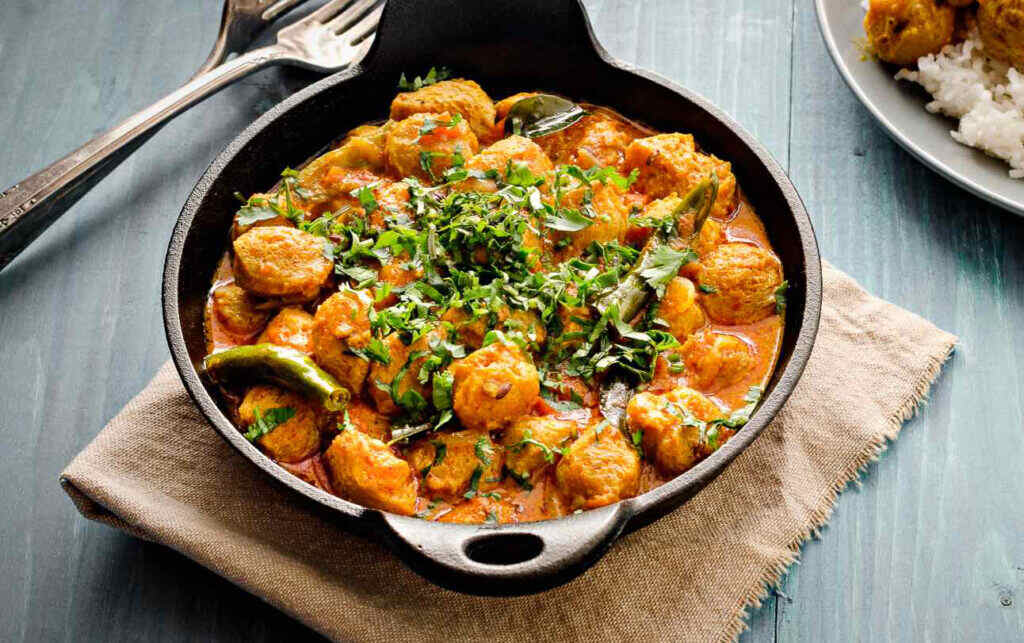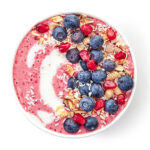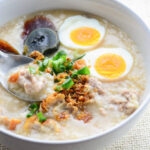“Soya Chunks Coconut Curry is a flavorful and nutritious dish that combines protein-rich soya chunks with creamy coconut milk and aromatic spices. Popular in South Asian and Southeast Asian cuisines, this dish offers a delicious blend of textures and flavors. With its hearty nature and healthful ingredients, Soya Chunks Coconut Curry is a satisfying choice for vegetarians and anyone seeking a tasty, plant-based meal option.”
| Ingredients | |
| 1 | 1 cup dried soya chunks |
| 2 | 1 can (14 oz) coconut milk |
| 3 | 1 onion, finely chopped |
| 4 | 2 tomatoes, finely chopped |
| 5 | 2-3 cloves garlic, minced |
| 6 | 1-inch piece of ginger, grated |
| 7 | 1 green chili, chopped (optional, adjust to taste) |
| 8 | 1 teaspoon cumin seeds |
| 9 | 1 teaspoon ground coriander |
| 10 | 1/2 teaspoon turmeric powder |
| 11 | Half a teaspoon of red chili powder, or to taste |
| 12 | 1 teaspoon garam masala |
| 13 | Salt to taste |
| 14 | 2 tablespoons cooking oil |
| 15 | Fresh cilantro leaves for garnish |
Step-by-step cooking instruction of Soya Chunks Coconut Curry:
Step-1 Prepare the Soya Chunks: Start by soaking the dried soya chunks in hot water for about 15-20 minutes or until they become soft and plump. Once rehydrated, drain the water and squeeze out any excess moisture from the soya chunks. Set aside.
Step-2 Sauté Aromatics: Heat oil in a large pan or skillet over medium heat. Add the cumin seeds and let them sear for a little while. Then, add chopped onions and sauté until they turn translucent.
Step-3 Add Spices: Stir in minced garlic, grated ginger, and chopped green chili (if using). Sauté for a minute until the raw aroma of the garlic disappears. Then, add ground coriander, turmeric powder, red chili powder, and salt. Mix well to combine.
Step-4 Cook Tomatoes: Add chopped tomatoes to the pan and cook until they soften and break down, forming a thick paste.
Step-5 Make the Coconut Curry: Once the tomatoes are cooked down, pour in the coconut milk. Stir well to combine with the tomato-onion mixture. Let the curry gently simmer for a while.
Step-6 Add Soya Chunks: Carefully add the rehydrated soya chunks to the coconut curry. Stir gently to coat the soya chunks with the curry sauce.
Step-7 Simmer: Cover the pan and let the curry simmer over low heat for about 10-15 minutes, allowing the flavors to meld together and the soya chunks to absorb the sauce.
Step-8 Adjust Seasoning: Taste the curry and adjust the seasoning according to your preference. You can add more salt or spice if needed.
Step-9 Finish and Serve: Once the soya chunks are tender and the curry has reached your desired consistency, sprinkle garam masala over the curry and give it a final stir. Garnish with fresh cilantro leaves.
Step-10 Serve: Serve hot with steamed rice, naan bread, or roti. Enjoy your Soya Chunks Coconut Curry!
Nutritional values of Soya Chunks Coconut Curry:
The nutritional value of Soya Chunks Coconut Curry can vary depending on the specific ingredients and proportions used in the recipe. However, here’s a general overview of the nutritional components you can expect in a typical serving of Soya Chunks Coconut Curry:
| 1 | Protein: Soya chunks are a rich source of plant-based protein. They supply every essential amino acid required for the body’s tissue growth and repair. Depending on the serving size, Soya Chunks Coconut Curry can offer a significant amount of protein, making it a suitable option for vegetarians and vegans. |
| 2 | Healthy Fats: Coconut milk, a key ingredient in the curry, contains healthy fats, including medium-chain triglycerides (MCTs). While coconut milk is high in saturated fats, the type of fats it contains may have some health benefits, such as promoting satiety and aiding in weight management when consumed in moderation. |
| 3 | Carbohydrates: The carbohydrates in Soya Chunks Coconut Curry primarily come from ingredients like onions, tomatoes, and any added starchy components such as rice or bread served with the dish. Carbohydrates provide energy to fuel various bodily functions. |
| 4 | Fiber: Depending on the amount of vegetables used in the curry, it may provide dietary fiber. In addition to helping control blood sugar levels and promoting feelings of fullness, fiber is crucial for the functioning of the digestive system. |
| 5 | Vitamins and Minerals: Soya chunks and coconut milk both contain various vitamins and minerals. Soy chunks are especially high in phosphorus, calcium, magnesium, and iron. Coconut milk contains vitamins C, E, B vitamins, and minerals such as manganese, copper, and selenium. |
| 6 | Antioxidants and Phytonutrients: The spices used in the curry, such as ginger, garlic, cumin, and coriander, contribute antioxidants and phytonutrients that have potential health benefits, including anti-inflammatory and immune-boosting properties. |
Background History of Soya Chunks Coconut Curry
The history of Soya Chunks Coconut Curry intertwines with the culinary traditions of South Asia, particularly in countries like India, Sri Lanka, and Bangladesh, where coconut milk-based curries are a staple part of the cuisine. Here’s a brief background history:
Origin of Soya Chunks: Soya chunks, also known as textured vegetable protein (TVP) or soy meat, originated as a byproduct of soybean oil extraction. This high-protein meat substitute gained popularity in the mid-20th century, particularly among vegetarians and individuals seeking plant-based protein alternatives.
Introduction of Coconut Curry: Coconut-based curries have a long history in South Asian cuisine. Coconut milk, derived from the flesh of mature coconuts, is a versatile ingredient used in a variety of savory and sweet dishes. Coconut curries are known for their creamy texture, rich flavor, and aromatic spices.
Innovation in Vegetarian Cuisine: With the rise of vegetarianism and veganism globally, there has been a growing demand for innovative plant-based dishes that are both nutritious and flavorful. Soya chunks, with their meat-like texture and high protein content, became a popular ingredient in vegetarian cooking, including curries.
Evolution of Soya Chunks Coconut Curry: Soya Chunks Coconut Curry likely emerged as a fusion of traditional South Asian curry recipes with the inclusion of soya chunks to enhance the protein content and texture of the dish. This combination offers a satisfying and nutritious meal option for vegetarians and vegans, as well as anyone looking to reduce their meat consumption.
Cultural Significance: In South Asian cultures, food plays a central role in social gatherings, religious ceremonies, and everyday life. Coconut-based dishes are often enjoyed during festivals, celebrations, and family meals. Soya Chunks Coconut Curry has become a popular choice for both home-cooked meals and restaurant menus, reflecting the diverse and dynamic nature of South Asian cuisine.
| Advantages of Soya Chunks Coconut Curry | |
| 1 | High Protein Content: Soya chunks are a rich source of plant-based protein, making Soya Chunks Coconut Curry an excellent option for vegetarians and vegans looking to meet their protein needs. |
| 2 | Nutrient-Rich Ingredients: The curry incorporates nutritious ingredients such as coconut milk, onions, tomatoes, and spices, providing essential vitamins, minerals, and antioxidants. |
| 3 | Versatility: Soya Chunks Coconut Curry can be customized with various vegetables, spices, and herbs according to personal preferences and dietary requirements. |
| 4 | Tasty and Flavorful: The combination of coconut milk and aromatic spices creates a deliciously creamy and flavorful curry that appeals to a wide range of tastes. |
| Satiety: The combination of protein and healthy fats in Soya Chunks Coconut Curry can help promote feelings of fullness and satiety, making it a satisfying meal option. |
| Disadvantages of Soya Chunks Coconut Curry | |
| 1 | High Calorie and Fat Content: Coconut milk, while nutritious, is high in calories and saturated fats. Consuming Soya Chunks Coconut Curry in large quantities or frequently may contribute to excess calorie intake. |
| 2 | Allergies and Sensitivities: Soya chunks are a common allergen, and individuals with soy allergies should avoid this dish. Additionally, coconut allergies or sensitivities may limit some people from enjoying this curry. |
| 3 | Potential Digestive Issues: Some individuals may experience digestive discomfort or bloating from consuming soy products or rich, creamy curries like Soya Chunks Coconut Curry, particularly if they have sensitivities or intolerances to these ingredients. |
| 4 | Preparation Time: While not excessively time-consuming, preparing Soya Chunks Coconut Curry from scratch requires soaking the soya chunks, chopping vegetables, and simmering the curry, which may not be feasible for people with hectic schedules or little free time. |
| 5 | Availability of Ingredients: Soya chunks and coconut milk may not be readily available in all regions, making it challenging for some individuals to prepare this dish. |
Compare with Similar meal of Soya Chunks Coconut Curry:
Similar meals to Soya Chunks Coconut Curry include dishes that feature similar ingredients or flavors, particularly those that incorporate soy-based protein and coconut milk in a curry or stew-like preparation. Here are a few examples:
| 1 | Tofu Coconut Curry: Substitute soya chunks with tofu cubes and prepare a coconut curry using similar spices and ingredients. Tofu, like soya chunks, absorbs the flavors of the curry and provides a protein-rich base. |
| 2 | Chickpea Coconut Curry: Use chickpeas (garbanzo beans) as the main protein source in a coconut curry. Chickpeas offer a hearty texture and pair well with coconut milk and spices. You can also add vegetables like spinach, bell peppers, or potatoes for added nutrition. |
| 3 | Vegetable Korma: Prepare a creamy vegetable korma using coconut milk as the base. Include a variety of vegetables such as carrots, peas, potatoes, and cauliflower, along with aromatic spices like cardamom, cinnamon, and cloves. This dish offers a rich and flavorful alternative to Soya Chunks Coconut Curry. |
| 4 | Paneer Coconut Curry: Paneer, a type of Indian cottage cheese, can be used instead of soya chunks to create a creamy and indulgent coconut curry. Paneer absorbs the flavors of the curry sauce and provides a satisfying texture similar to tofu or soya chunks. |
| 5 | Lentil Coconut Curry: Cook lentils (such as red lentils or brown lentils) in a coconut milk-based curry sauce flavored with spices like cumin, turmeric, and ginger. Lentils are a great source of protein and fiber, making this dish both nutritious and satisfying. |
| 6 | Fish Coconut Curry: For those who enjoy seafood, fish coconut curry is a delicious option. Use firm-fleshed fish such as cod, salmon, or tilapia, and simmer it in a coconut milk-based curry sauce with spices and vegetables. This dish offers a flavorful twist on traditional Soya Chunks Coconut Curry. |
Mostly questions asked about Soya Chunks Coconut Curry
1: What are soya chunks?
A: Soya chunks, also known as textured vegetable protein (TVP) or soy meat, are a plant-based protein made from defatted soy flour. They have a meat-like texture and are often used as a meat substitute in vegetarian and vegan dishes.
2: How do I cook soya chunks for curry?
A: Soya chunks should be soaked in hot water for about 15-20 minutes until they become soft and plump. After soaking, drain the water and squeeze out any excess moisture before adding them to the curry.
3: Is Soya Chunks Coconut Curry vegan?
A: Yes, Soya Chunks Coconut Curry can be vegan if prepared with plant-based ingredients and without any animal products such as meat, dairy, or honey.
4: Can I use canned coconut milk for the curry?
A: Yes, canned coconut milk is commonly used in Soya Chunks Coconut Curry. It gives the curry sauce a thick, creamy foundation. Be sure to shake the can well before opening and using the coconut milk.
5: Are there any alternatives to coconut milk?
A: Yes, if you prefer, you can use other dairy-free milk alternatives such as almond milk or cashew milk in place of coconut milk. However, the flavor and consistency of the curry may vary slightly.
6: How do I make the curry less spicy?
A: To make Soya Chunks Coconut Curry less spicy, reduce the amount of chili powder or omit the green chili altogether. You can also add a dollop of yogurt or coconut cream to mellow out the spice level.
7: Can I freeze Soya Chunks Coconut Curry?
A: Yes, Soya Chunks Coconut Curry can be frozen for future use. Before putting the curry in freezer bags or airtight containers, let it cool fully. For two to three months, you can store it in the freezer. Thaw in the fridge for a full night before reheating.
8: What are the health benefits of soya chunks?
A: Soya chunks are a good source of plant-based protein, fiber, vitamins, and minerals. They are low in fat and cholesterol-free, making them a nutritious addition to a balanced diet. Soya chunks may also help reduce the risk of heart disease and improve bone health.
9: Can I add vegetables to Soya Chunks Coconut Curry?
A: Yes, adding vegetables such as carrots, potatoes, bell peppers, peas, or spinach to Soya Chunks Coconut Curry can enhance its nutritional value and flavor. Simply chop the vegetables and add them to the curry along with the soya chunks.
10: Is Soya Chunks Coconut Curry gluten-free?
A: Yes, Soya Chunks Coconut Curry is naturally gluten-free as long as the ingredients used are free from gluten-containing grains. However, it’s essential to check labels carefully, especially for packaged spices or sauces, as they may contain hidden sources of gluten.







